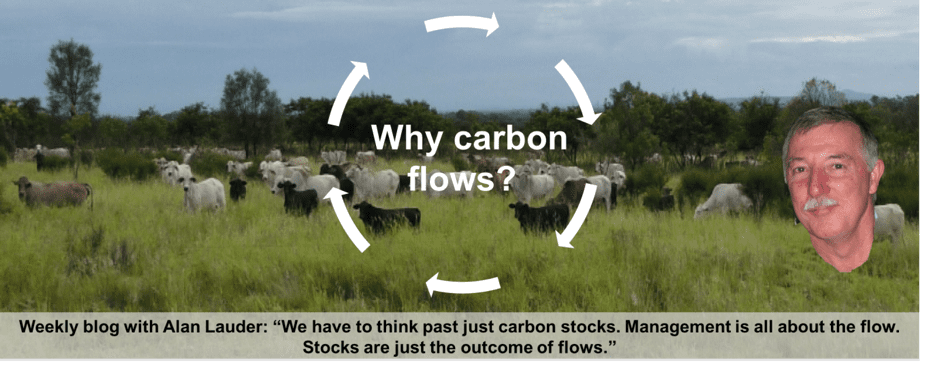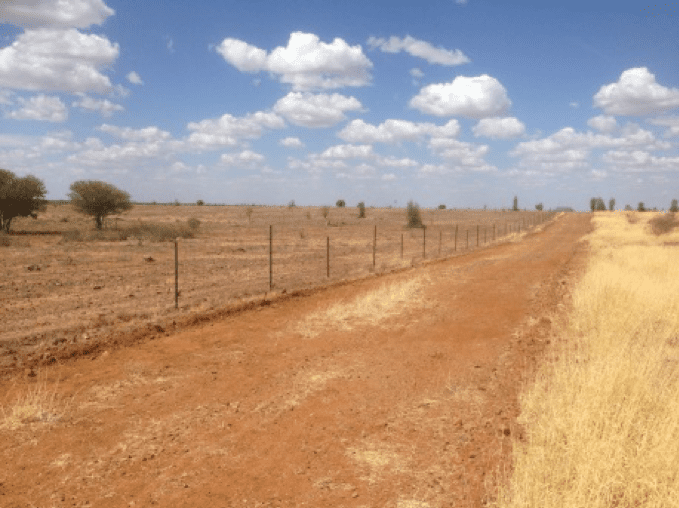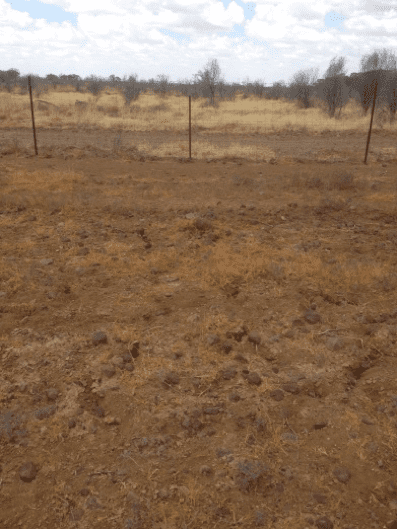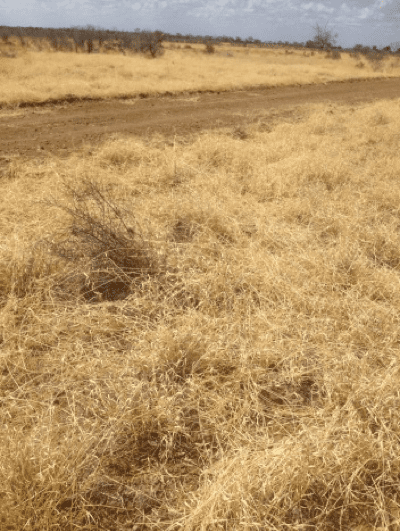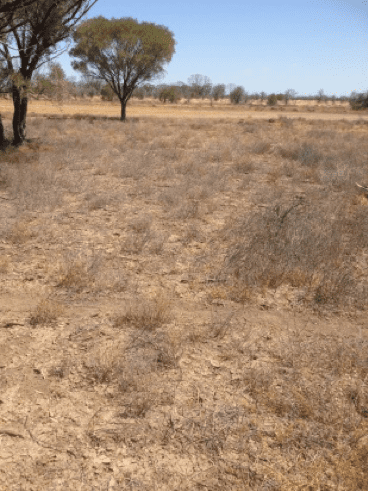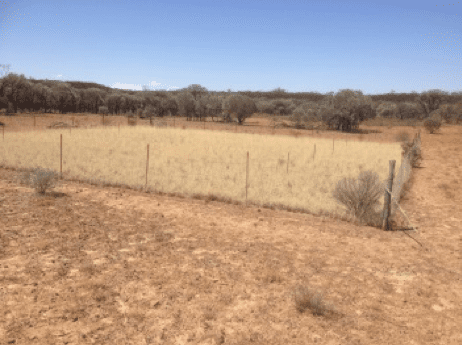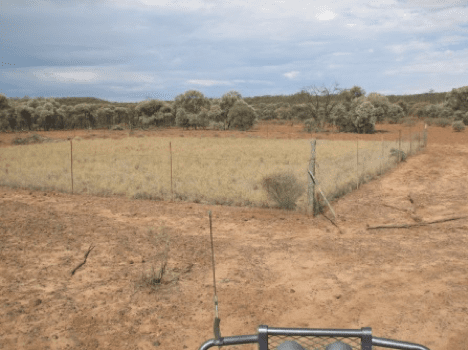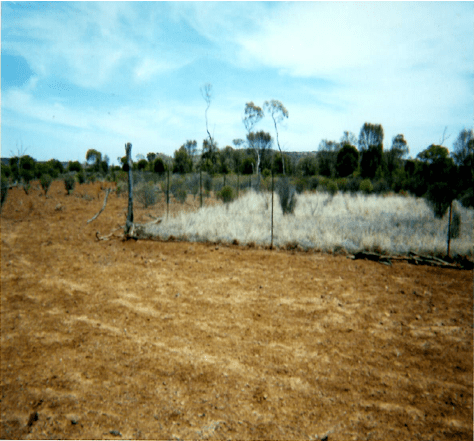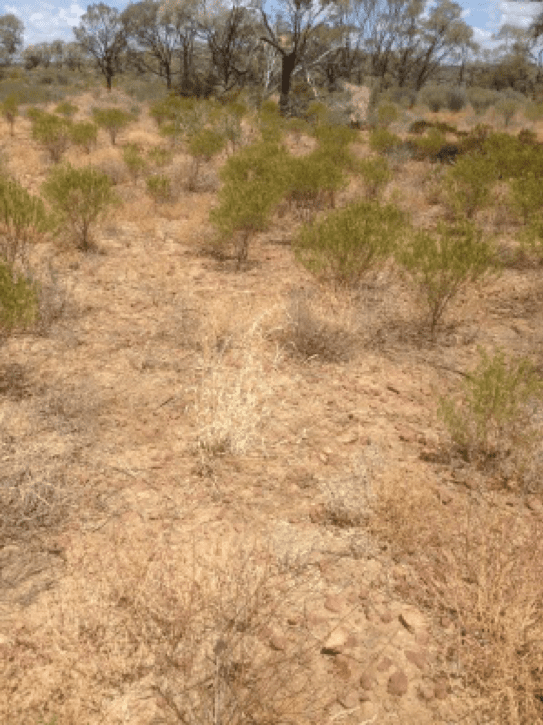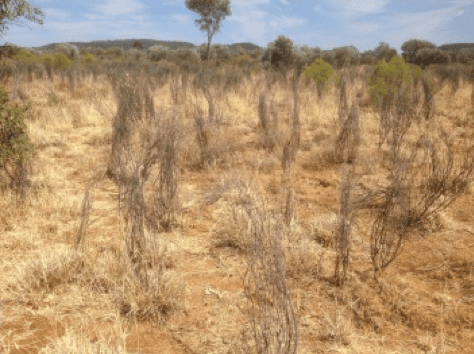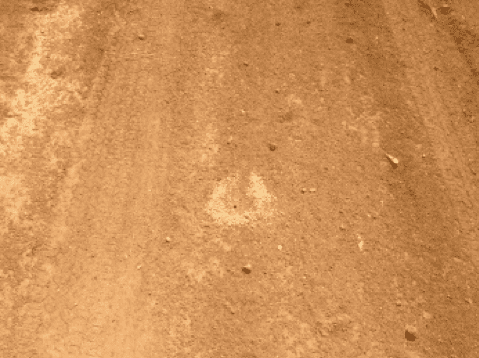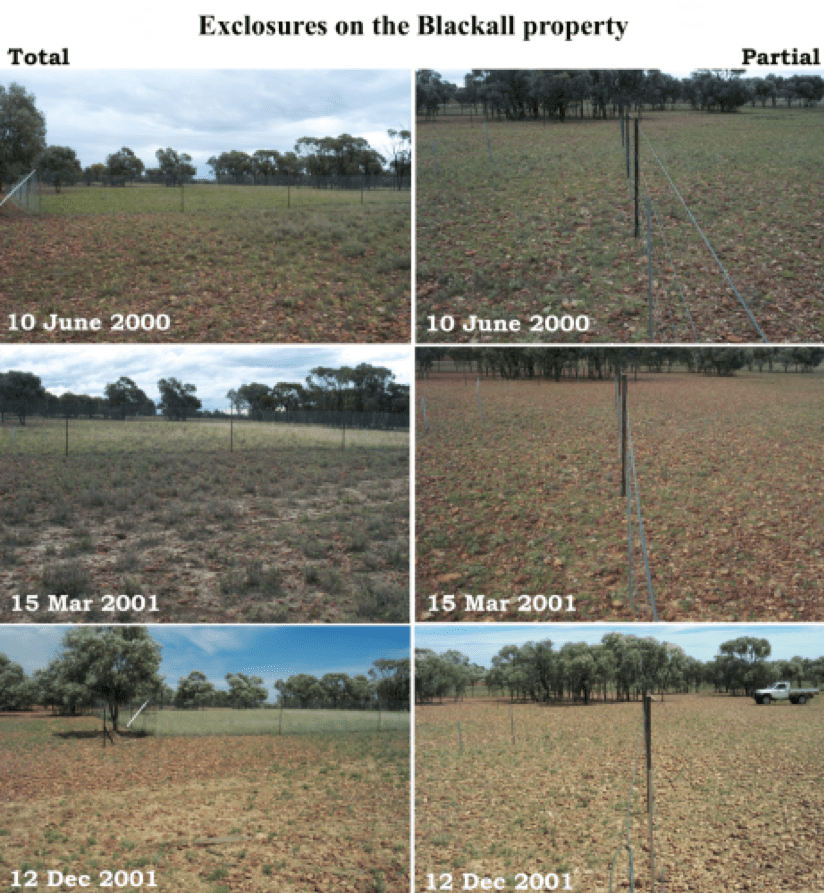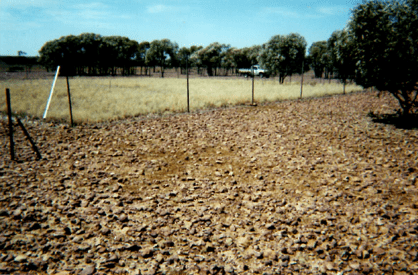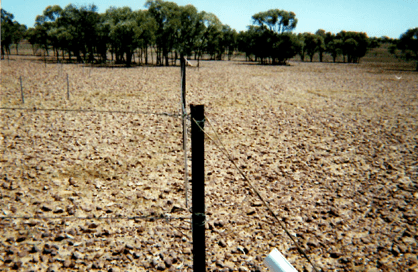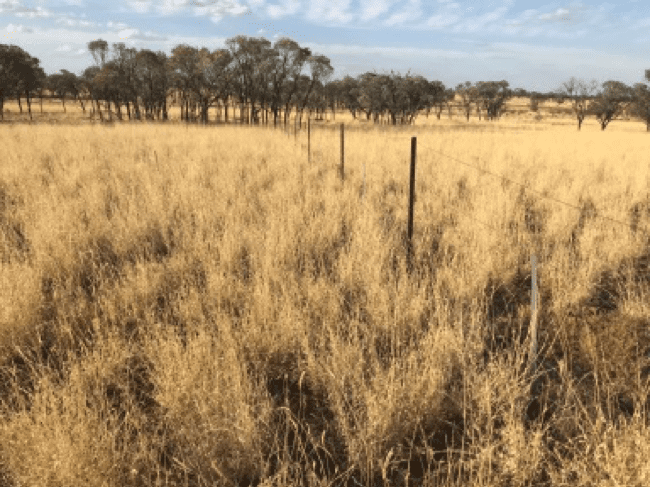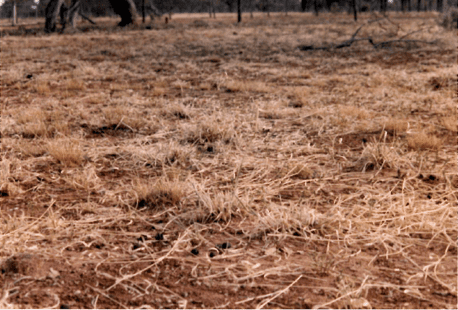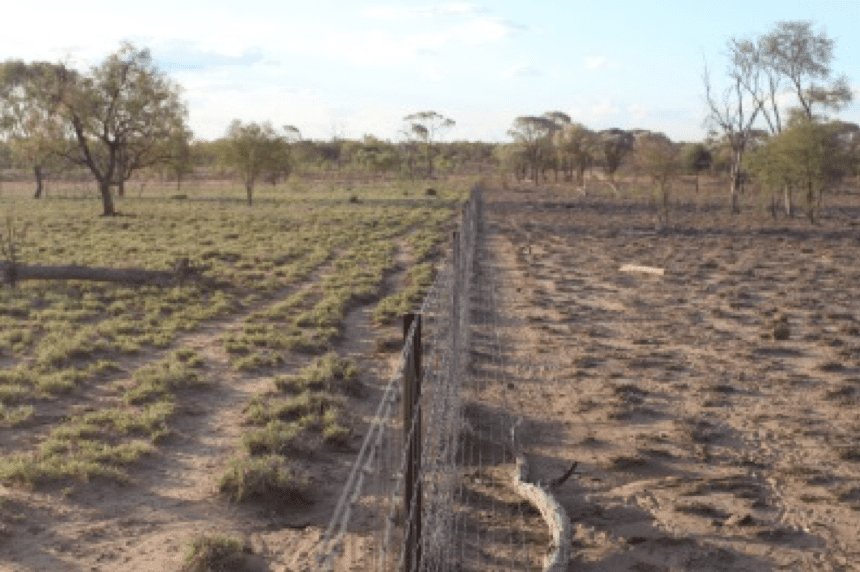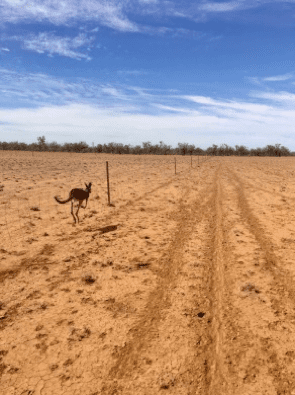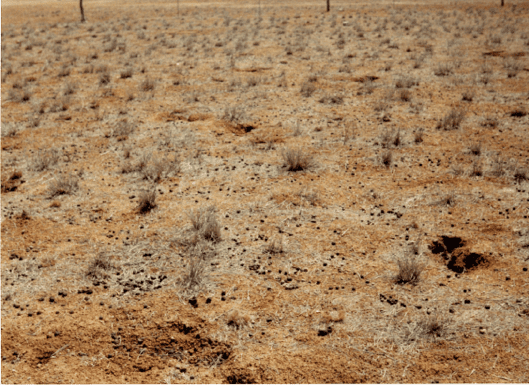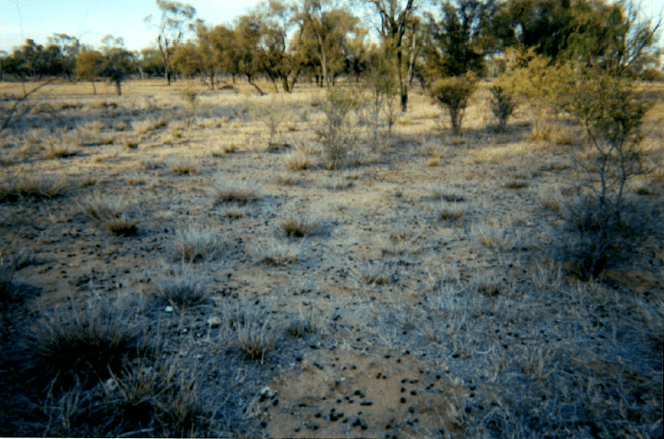Alan Lauder, experienced grazier and author of the book “Carbon Grazing – The Missing Link”, looks at the influence of kangaroo populations on soil carbon levels, livestock methane emissions and pasture management in drought, and why control measures are in the best interests of environmental outcomes.
ANY animal that is eating grass when it is trying to grow immediately after rain is reducing the flow of carbon into the paddock. This results in reduced ground cover and lowers potential production. If the grazing pressure is excessive it can reduce paddock health. This is why removing sheep and cattle from pastures whenever possible after rain is a good idea, but kangaroos are an animal that we can’t manage when they are present.
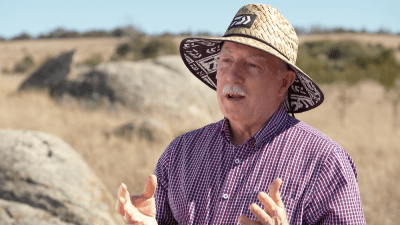
Alan Lauder discusses carbon flows in a July 2018 Soils for Life video. To watch video click here.
Kangaroos have the ability to get through normal fences, so can turn up in mass after storms and consume new growth, sometimes the lot if pastures are very low.
Kangaroos do the most damage to the environment during extended dry periods when perennial grasses are forced to go into dormancy more often. To come out of dormancy after any rain that falls, they call on stored energy reserves. If perennial grasses are continually not allowed to grow and replace these energy reserves after rain, then these reserves run down. This reduces perennial grass resilience and increases the risk of them dying.
This story, about a kangaroo proof boundary fence, illustrates why controlling kangaroos is in the best interest of graziers managing carbon flows to maximise profits and environmental outcomes. This message is even more important in the face of increasingly unreliable rainfall and discussion about drought policy.
Landscape response after a kangaroo proof boundary fence was built
Photo 1: The outcome of restricting kangaroos to a sensible population (October 2018)
Photo 1 was taken on a property west of Blackall, Queensland, Australia at the start of October 2018. The boundary fence in the photo is kangaroo proof. It was built around the entire 80,000 acres (32,000 ha) of the property in 2010 and then the kangaroo population was reduced to a population similar to the size found at the time of European settlement. The photo highlights that cattle numbers are well managed to ensure ground cover is maintained.
Photo 2: The kangaroo proof fence defending another part of the property (October 2018)
Photo 2 is looking across the kangaroo proof boundary fence from another neighbour’s property.
There was good rain in February/March 2018 and then no rain was recorded during the six months prior to these photos being taken at the start of October.
The cracks in the ground in the foreground highlight that the soil is very dry because of no rain for a long time. However, photo 2 highlights that drought arrives sooner for some producers than others, and the arrival of drought comes down to more than just rainfall.
Photo 3: Prolific grass through being allowed to grow (October 2018)
Photo 3 was taken about 400 metres (440 yards) off the boundary fence in photo 2. It highlights that there can be standing pasture well after it has rained, if the pasture is allowed to grow after rain in the first place and then what grows is not over consumed too early, be it by kangaroos or cattle.
Photo 4: What reduced resilience looks like (October 2018)
Photo 4 was taken on a third neighbour’s property looking back at the kangaroo proof boundary fence. The boundary fence is at the top of the photo on the other side of the council road. The yellow at the top of the photo is thick grass just like in the other photos.
The foreground highlights that the good February/March rain only grew some annual grass and weeds in this area, because perennial grasses are missing. A paddock that has lost perennial grasses due to ongoing grazing pressure after rain by cattle or kangaroos, will always go into drought quicker.
Inside Idalia National Park where there are kangaroos but no sheep or cattle
Photo 5: A fenced area inside Idalia National Park west of Blackall at the start of October 2018
Photo 5 was taken at the same time as photos 1 – 4. It was taken inside Idalia National Park that joins the property in photos 1-4.
This fenced off area inside Idalia National Park documents the ability of kangaroos to shut down carbon flows into the landscape, in exactly the same way that poorly managed sheep and cattle shut down carbon flows. While no soil samples have been taken, judging by the vegetation, it is to be expected that soil carbon would be higher in the fenced off area.
Photo 6: The Idalia National Park exclosure nine years earlier
Photo 6 is a photo I took of the Idalia exclosure on 14 November 2009.
The commercial property has regenerated following the building of the kangaroo proof fence in 2010 and kangaroos being brought under control, but the National Park has not changed from2009 to 2018, and is still degraded unfortunately.
Photo 7: Another exclosure in Idalia National Park on 14 November 2009
I took photo 7 to highlight that the pattern of land degradation was the same in the National Park, regardless of soil type.
There was good rain at the start of 2009 but it meant little for carbon flows in the park, except for inside the exclosures. The National Park exclosures were the catalyst for the producer to build the kangaroo proof fence in 2010. They demonstrated what the true potential of the landscape was and what he could aim for if he built the fence. The producer could see that kangaroos were eroding his Natural Capital. He has always been on the cutting edge of change and understood that it is management of carbon flows that underpins Natural Capital.
If kangaroos keep hammering a patch of landscape, in the end plants start to die. As some plants die, this increases the grazing pressure on the remaining plants and so the downward spiral continues. Plants are protected by how many mates they have to share the grazing pressure.
It is carbon flows introduced by plants that feed the soil microbes necessary for keeping the soil well-structured and fertile. Plants fail first, then the soil fails, because there are reduced carbon flows to keep the soil functional.
Man-made watering points created the problem
Kangaroos lived in harmony with the landscape prior to European settlement, but with the introduction of artificial watering points, we changed all that and dramatically increased the population of kangaroos.
Pre-European settlement, when surface water dried up during dry times, kangaroos had to move on or perish. In inland Queensland, it is suggested that up to 80% of kangaroos would perish in times of drought.
When rain arrived the landscape had to regenerate again. Nature made sure there weren’t too many animals to impact the regeneration phase.
During dry times when there was little permanent water in the landscape, the aboriginals and kangaroos all had to move back to the only permanent water. This made the kangaroos more vulnerable to being killed. The creek that ran through my Cunnamulla property that I sold in 2002 was called “Widgeegoara” by the aboriginals. Widgeeoara means “turn back, go no further” i.e. head back to the Warrego river 75 km (45 miles) away, which is where the only permanent water was.
The Blackall producer focused on water first
The Blackall producer’s first attempt to overcome the problem of excessive kangaroos was to remove water troughs and put in tanks that the cattle could drink out of but the kangaroos could not access. A case of taking things back to the way they were before European settlement. The tanks were installed in 2002.
While the tanks did lead to an improvement in the landscape and more than paid for the investment, they only supplied partial control of grazing pressure from kangaroos.
Kangaroos have evolved to cope with Australia’s climate that is the most variable in the world. They release very little water from their body as urine.
Depending on the time of year and the moisture level of the grass, the kangaroos on the Blackall property were drinking about every five days prior to the removal of the water troughs. While some kangaroos were forced to move on after the installation of the tanks, others were going to man-made waters elsewhere and then returning.
Rain that didn’t produce surface water, but did increase grass moisture enough for kangaroos to function, also allowed them to return to the property.
The producer finally accepted that building the fence was the only way he could return his property to pristine condition.
Grazing pressure led to woody weeds replacing perennial grasses, this is now reversing
Pre-European settlement, wildfires played a role in stopping excessive encroachment of woody vegetation into the landscape. The other part of the equation was the ability of healthy perennial grasses to out compete germinating woody seedlings for water and nutrients. This is why it is so important to keep perennial grasses healthy to maintain the correct balance of a landscape.
Photo 9: Phase one of regeneration – the arrival of a perennial grass plant to act as a seed source (October 2018)
As we all know, you can’t get regeneration without seed. Before the kangaroo proof boundary fence was built, there was little perennial grass seed being produced on the hard soils. This was because the population of perennial grasses had become very low. Because of the low perennial grass population, the number of kangaroos present, even when cattle were removed, were able to stop most seed sets and also apply too much grazing pressure on perennial grass seedlings to allow them to establish.
After the kangaroo population was reduced to a sensible number, it was a case of waiting for perennial grass plants to establish in degraded areas and become a seed source to regenerate the area around them.
Photo 9 shows the arrival of a perennial mitchell grass plant. Looking at the size of it, it is not very old, so is a seed source that has arrived in the recent past. After over fifteen years of observing this area, photo 9 was a quantum leap forward. This is the first phase of regeneration.
The good soils on the property have regenerated as photos 1-4 show, however the fragile soils that had become more degraded, are taking longer, which is normal.
Photo 10: Phase two of regeneration (October 2018)
When the harder more fragile soils degrade, woody weeds will often replace perennial grasses.
Photo 10 shows grass really starting to replace woody weeds. Some woody weeds have a fixed life cycle, so management has to ensure that there is sufficient seed to allow perennial grasses to step in when one cycle ends and before the next one starts. For years there was virtually no grass in this area.
When I was on the property a few years earlier, this particular area looked like photo 9 and was in phase one of regeneration, with just isolated perennial grasses.
Ants and birds are the big winners with fewer kangaroos
Photo 11: Abundant seed now being produced for ants to collect
The road in photo 11 was graded in September 2018, a month before the photo was taken at the start of October 2018. Remembering that no rain was recorded since March and the road was freshly graded, ants were still collecting plenty of seed five months after the rain ended.
Plant growth and seed production is really a measure of carbon flows. This is why discussion about kangaroos needs to be couched in terms of their impact on carbon flows.
Exclosures constructed on the Blackall property provided further evidence
Apart from the exclosures built in Idalia National Park, exclosures were also built on the Backall producer’s property. These supplied the producer with further understanding of the true impact of kangaroos.
A total and a partial exclosure was built on the producer’s property in close proximity. The partial exclosure was built with running wire and kept out commercial animals, but kangaroos could get in. The total exclosure was built with netting and excluded both commercial animals and kangaroos.
Photo 12: A netting and running wire exclosure built on the Blackall property
Like in the national park, the total exclusion improved the landscape back to pristine condition. However, kangaroos getting into the partial exclosure maintained it in the same condition as the paddock outside, as photos 12 and 13 show.
Photo 13: October 2002 and the pattern is still the same
For years, the running wire exclosure demonstrated that kangaroos will over-ride decisions made to improve livestock management. In 2009, when I took photos of the Idalia National park exclosures, inside the running wire exclosure on the property was still the same as the rest of the paddock.
Photo 14: Running wire exclosure October 2018 – It took the building of the kangaroo proof boundary fence to regenerate the running wire exclosure
With the building of the kangaroo proof fence around the entire property, there was a dramatic change inside the running wire exclosure. The landscape inside it has now totally regenerated and is in the same condition as the netting one that showed the true production potential of the landscape many years earlier.
The property now has great ground cover as far as the eye can see, and when photo 14 was taken at the start of October 2018, the Blackall district was drought declared.
The ability of a paddock to produce carbon flows from rain is the true measure of paddock resilience. In photos 1-4, resilience started at the kangaroo proof fence.
To my surprise, the day I took photo 14, I noticed that there was a green tinge in the stems at the base of the Mitchell grass in this area, six months after the last rain. The green tinge indicated the landscape was ready to respond to a marginal fall of rain and produce some carbon flows, – a true sign of resilience.
The slightly green stems represented healthy plants sitting in a functional soil that must have had some moisture at depth, which the plants with deep roots had managed to reach.
Kangaroos can shut down more growth than they actually eat
Traditional discussion will allocate a percentage of total grazing pressure to all the different animals present based on how much they eat. A kangaroo is considered to eat less than what a sheep eats, and this is totally true. However, this approach misses the point if you are a big picture person i.e. a systems thinker.
It is not just what a kangaroo eats. There is also the issue of the amount of growth they shut down i.e. reduction of carbon flows into the paddock. They do this by getting through normal fences and turning up when plants are trying to grow after rain. Prior to European settlement, this was not an issue because their population was much lower.
Scientists I met in South Africa in the 1990’s, put a figure on lost growth from animals eating plants when they are trying to grow after rain. They said that resting average pastures for three to eight weeks after rain, increased pasture production by 30 – 80%. There would also be a proportionate increase in the amount of carbon going under ground to build roots and being released as liquid carbon in the form of root exudates for soil microbes.
The number of stooling points influences carbon flows after rain
Apart from protecting the soil from wind and water erosion, there is another practical reason why ground cover should be maintained as high as reasonably possible and not eaten right down to ground level or cut off near the base as kangaroos can do. The number of stooling points increases with pasture height and the more stooling points there are on stems, the quicker a plant can bulk up after rain.
Photo 15: Stems cut off by kangaroos and left on the ground
Photo 15 demonstrates that kangaroos have the ability to cut off stems at the base of perennial grasses, using their protruding scissor teeth. When they do this, they are not eating the stems, simply removing them to get at more digestible parts of the plant.
Photo 15 is a good example of kangaroos removing stooling points and reducing the capacity of perennial grasses to respond to rain. It is ironic that the photos were taken after 20,000 acres (8,000 ha) had been locked up for a month after rain to increase ground cover on a Cunnamulla property. Even more ironic that this was the last pasture growing rain before a drought set in.
On my Cunnamulla property, I had a formed up road in one section of the narrow laneway through the property. Because it was possible to drive at 100 km per hour (60 mph), I often surprised kangaroos just before dark when they came out to feed. As they madly hopped along the fence outside the window, I sometimes noticed a grass stem sticking out of their mouth. In their haste to get away they had obviously not released the stem from between their two teeth, which they had just cut.
The Blackall producer was better able to maintain stooling points after the boundary fence was built, because he only had to focus on adjusting cattle numbers depending on how the season was traveling.
Prof Bob Miles, a retired rangeland scientist sent me this that is very interesting, “Kangaroos have protruding dentition. That is their teeth point forward and can therefore eat shoots off below ground level. Sheep and cows cannot. Cows have a big nose so only eat a few centimetres above the ground. Sheep open their gums and eat at ground level”.
Kangaroos applying grazing pressure after rain can prolong drought
Photo 16: Rain not increasing ground cover outside a kangaroo proof fence at Cunnamulla
Photo 16 is a kangaroo proof fence built around 15,000 acres (6,000 ha) north of Cunnamulla. On the left hand side of the fence, 13,000 kangaroos were removed from the 15,000 acres over three years after the fence was built.
The left hand side of the fence highlights the ability of the property to now respond to rain during dry periods.
It is when grass is short, that grazing pressure has to be really well managed.
CSIRO research compared kangaroos and sheep for landscape impact
In the late 1990’s, CSIRO rangelands scientist Allan Wilson told me that he was involved in grazing trials to quantify the true impact of sheep and kangaroos on the landscape. To do this, they put only kangaroos into a fenced off area and likewise only sheep into a fenced off area. He said that the kangaroos did more damage than sheep when contained.
My memory fails me on the exact stocking rate, but I think they stocked the fenced areas on the basis that a kangaroo eats 60% of what a sheep eats.
Government policy is protecting some kangaroo species where they didn’t previously exist
Photo 17: This grey kangaroo is now in an area where the species did not exist at the time of European settlement
Photo 17 was taken recently on my former Cunnamulla property that I sold in 2002. Unfortunately it is suffering a terrible drought, worse than anything I went through.
My father was born in 1914 and grew up in the Cunnamulla area. He told me there were no grey kangaroos in the area while he was growing up and others of his vintage confirmed this to be true. Now, grey kangaroos account for the bulk of the kangaroos in the area.
It was the introduction of man-made watering points that has allowed this non-migratory kangaroo species to move further inland and establish where they were not before. This has placed unprecedented grazing pressure on this inland country, which had traditionally been populated by the migratory red and blue kangaroo.
Continuous grazing is the worst form of land management, yet this is exactly what these grey kangaroos are responsible for, because of their small range.
Government policy is now protecting this grey species of kangaroo by stipulating that females can’t be harvested below a minimum body weight. This legislated weight is higher than the weight they have to reach to reproduce i.e. they are reproducing before they can be legally be harvested.
Unfortunately, government policy based on a lack of understanding of this area’s history is helping to degrade the landscape. Go to any forum today discussing policy and everybody is talking about the need to look after “Natural Capital”.
Drought policy needs to link kangaroos with earlier arrival of drought
With the current extensive drought in Eastern Australia, there is a lot of debate about drought policy and where changes need to occur.
Management that increases carbon flows, from any rain that falls, delays the arrival of drought as all the photos show. This is a good starting point for improving policy.
Photo 18: Kangaroos consuming saved groundcover
Photo 18 is a paddock at Cunnamulla that was locked up during the 1990’s to maintain ground cover for future use. However it was completely eaten out by kangaroos as the kangaroo dung confirms.
Unfortunately, kangaroo policy is eroding drought policy and this is costing the broader community, because drought subsidies are larger than they need to be.
When the whole of his district was drought declared in October 2018, the last thing the Blackall producer was thinking of was a drought subsidy.
Sharing the blame properly
Prof Brian Roberts of the University of Southern Queensland “Land Use Study Centre” explained to me years ago why there are misconceptions around the impact of different animals on the landscape. He said that it’s the animal in the landscape last that is blamed for the outcome, however, he pointed out that the ones that precede the ones there last, are also responsible for the final outcome.
Photo 19: Evidence of a high kangaroo presence
Photo 19 was taken on the Blackall property prior to the fence being built. If this photo had sheep or cattle in the background, to the untrained eye, it would make them responsible for the state of the paddock. However the huge amount of kangaroo dung on the ground tells a different story.
Kangaroos increase methane produced by cattle
The cornerstone of reducing methane produced by cattle and sheep is to improve the digestibility of their diet.
A kangaroo researcher from the University of Sydney told me that kangaroos are more selective in what they eat than even sheep are. When kangaroos remove the most digestible parts of the pasture, what is left behind for cattle to eat is less digestible. This results in cattle producing more methane per kg of production because they are on a lesser quality diet. What kangaroos are doing is changing the carbon:nitrogen ratio of what is available for cattle to eat.
A new understanding of livestock methane is now developing. Climate scientists world-wide are now starting to realise that provided the ongoing methane emissions from sheep and cattle in any country are stable year after year, in other words, animal numbers are not increasing, then these ongoing emissions do not change the climate. Methane is a short term gas (life of 12 years), so the methane being produced today is only replacing the methane produced 12 years ago that has now broken down. Hence todays emissions are not increasing the atmospheric balance of methane. Put simply, these ongoing methane emissions are not changing the net balance of greenhouse gases in the atmosphere, the basis of climate change. However, any management that leads to a reduction in methane emissions is actually reversing climate change.
Kangaroos can taint pastures for other animals
Kangaroos have evolved to be very efficient in their utilisation of water. As a result, they have a very concentrated urine. Their urine is so concentrated that it can contain crystals in it and not much water.
When I was growing up my father told me that sheep would not eat grass that had been heavily grazed by kangaroos, because it was tainted by kangaroo urine. He said that it remained tainted until a shower of rain removed the smell.
I had to wait until the 1982 drought, before I was supplied with evidence that proved my father was spot on with what he knew. The 1982 drought was one of worst droughts of the twentieth century and I only had 10% of the sheep left on the Cunnamulla property, with the rest on agistment.
Near the homestead was a small area of buffel grass in a dormant state. It is a prolific growing grass, so I watered it for the few rams not on agistment. It was the middle of summer, so the buffel responded quickly. It was the only green grass on 50,000 acres. After the rams had been eating it for three days, the kangaroos discovered it. After that the rams never ate it again, although they were often foraging near it. Apart from all the kangaroo dung, there were marks on the ground everywhere from them dragging their tail as they ate. I then had to build a kangaroo proof fence around the area and water some more grass.
The atmosphere doesn’t understand the difference between short & long-term carbon
The large volume of dry grass inside the kangaroo proof boundary fence shown in photos 1-4, represents a lot of carbon that is not in the atmosphere, remembering that dry grass is 45% carbon. Roots are about 45% carbon and inside the fence, there would also be a much higher root volume.
A lot of climate policy is all about processes, not outcomes unfortunately. Because of carbon trading, we are focused on only the long-term carbon present in the landscape. However, the atmosphere does not understand the difference between what we call short-term carbon and long-term carbon. It only understands that if carbon is in the landscape, then it can’t be in the atmosphere.
Since the fence was built, the Blackall producer has been able to maintain ground cover by being able to manage what grows and what is being eaten by adjusting cattle numbers. While the actual amount of ground cover does vary over time because of rainfall, his minimum level of ground cover is now much higher since he built the fence. This minimum level of ground cover represents “long-term short-term carbon” when other paddocks in the district are spending time bare.
The subtleties are easy to overlook
The business model of the Blackall property is buying small steers and then growing them up and selling them as fat bullocks. Every time bullocks were sold and replaced with small steers, this reduced the grazing pressure, because the small steers only eat a third of what bullocks eat.
Before the fence was built, one particular year, kangaroos had a much greater impact on the business than the actual amount of pasture they ate would suggest.
Prior to the arrival of extra kangaroos, the season was starting to deteriorate but he had enough suitable grass in the pasture to fatten the bullocks on the property and sell them in October. The arrival of the kangaroos stopped this happening. As a result, he had to hold the bullocks and wait for the wet season to arrive, which did happen in January. The bullocks were eventually sold as fats in April.
The kangaroos had cost him six months production, because not being able to sell the bullocks as fats in October, meant he could not enter the next production cycle with small steers.
There was also the issue of the higher grazing pressure on the landscape that the held over bullocks applied, that replacement small steers would not have applied, given they only eat a third of what bullocks eat.
There are a lot of subtleties, and not just simple consumption figures, when discussing the impact of kangaroos.
Is a kangaroo industry in the best interests of the economy?
It is true that the kangaroo meat and hide industry is producing export income and providing jobs. However an alternative option for Australia is to move away from kangaroo harvesting and concentrate on exclusion fencing to reduce kangaroos to pre European settlement numbers, and so increase total export income via much increased sheep and cattle production.
If a cost benefit analysis was conducted, it is very likely that increased sheep and cattle production would produce much more export income than the total value of the current kangaroo industry. The improvement in the environment (Natural Capital) and less human stress from drought also needs to be valued
What is not often mentioned, is that the digestive system of sheep and cattle is more efficient than that of kangaroos.
A person in a recent ABC Landline program said that we need to utilise kangaroos more as a resource, especially given that they don’t have a carbon footprint. A quick look at the exclosures in Idalia National Park and those on the Blackall property, suggest that kangaroos do have a carbon footprint.
The best of both worlds with the boundary fence?
It is pretty obvious that the landscape was not fully functional before the kangaroo proof boundary fence was built around the Blackall property. Now it would be interesting to consider how the current producer’s landscape, that is now functional, is performing versus the one that existed pre European settlement, which was also functional.
While it is impossible to be conclusive in comparing the present landscape with the pre European settlement landscape that we did not witness, except for explorer reports. Others I have spoken to agree that it is likely that the Blackall producer is operating at a higher level, i.e. the level of carbon flows produced over time by his production system, for cattle to consume, would be higher than the carbon flows produced by the landscape pre settlement.
Putting aside the aspect of reliable introduced water, the current fenced landscape of the producer has a greater potential to maintain animals over time than the one in the past because of two factors that have changed: wild fires and moribund (rank) grass.
Fire is the more influential factor. Wild fires consume grass that could have been available for cattle to eat. It is known that these fires travelled great distances in the past because of no machinery to put them out. Pre European settlement, the pastures were able to recover from these fires that burnt grass down to ground level, because grazing pressure was not high in the recovery period. However these recovery processes take time and are periods of lower production. Especially if a wild fire precedes a run of dry years.
Low grazing pressure in the past would have, at times, produced moribund grass that is inefficient at introducing carbon into the landscape, just like over grazed unhealthy grass is inefficient at introducing carbon. Moribund grass is very inefficient at using available water. By removing the top off the grass all the time, the producer’s cattle are stopping it going moribund.
Getting back to basics, when graziers let animals, including kangaroos, harvest carbon flows too early following rain, they interfere with the biophysical conduit (leaves) that are responsible for introducing carbon into the landscape. The Blackall producer was only letting cattle harvest the “surplus”, not the means by which a usable surplus is generated. Also, he was not harvesting to ground level the way a fire does.
Conclusion
The photos taken inside Idalia National Park and on the Blackall property over time, highlight that kangaroos may cause more environmental damage than existing public debate suggests.
Rangeland scientists are aware that plagues of kangaroos are frustrating paddock management.
Kangaroos influence soil carbon levels because of their ability to get through fences and reduce the flow of carbon into the landscape when grasses are trying to grow after rain. They also increase the amount of methane produced by sheep and cattle because their very selective consumption of pastures changes the carbon:nitrogen ratio of the diet available to sheep and cattle.
At a policy level, consideration needs to be given to the ability of kangaroos, as an uncontrolled animal, to impact paddock resilience. This is resulting in the early arrival of droughts.
Australia would probably be better off financially and environmentally if properties were fenced to protect them from kangaroos, and the kangaroo harvesting industry slowly wound down as more fences are built. This is not suggesting that there should not be kangaroos on properties, instead a number like there was at the time of European settlement.
This article was originally published on the Soils For Life website – click here to view original article

